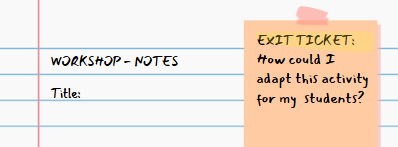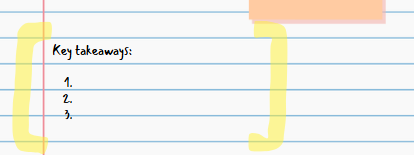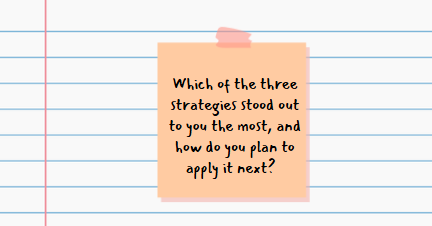How Primary ELT Teachers Can Use Reflection to Enhance Professional Growth

Attending a conference or workshop as part of professional development (PD) can be a rewarding experience. We get a chance to refine our practices with opportunities to learn new strategies, discover innovative teaching methods, and connect with fellow educators. However, once back in the primary English language teaching (ELT) classroom, it's easy for those exciting ideas to be filed away for another day.
 As Dewey reminds us, reflection is the key to learning: "We do not learn from experience...we learn from reflecting on experience." Just as we encourage our students to reflect on a range of their learning experiences, we too should take a moment to reflect on a variety of our own experiences. Whether you prefer a digital journal, a physical notebook, or even a teaching binder (or even a separate folder for each event), having a dedicated space to place these reflections is step one to helping you keep track of these thoughts in both the near and far future. The goal, however, is to keep these notes accessible in your daily routine.
As Dewey reminds us, reflection is the key to learning: "We do not learn from experience...we learn from reflecting on experience." Just as we encourage our students to reflect on a range of their learning experiences, we too should take a moment to reflect on a variety of our own experiences. Whether you prefer a digital journal, a physical notebook, or even a teaching binder (or even a separate folder for each event), having a dedicated space to place these reflections is step one to helping you keep track of these thoughts in both the near and far future. The goal, however, is to keep these notes accessible in your daily routine.
In this blog, I share three ideas, inspired by some primary ELT classroom favorites, to help create stronger connections between PD insights and your teaching context.
1. Reflect With Exit Tickets

Many of us use exit tickets as mini-assessment tasks at the end of a lesson to check for understanding and gather evidence of student progress before they move on to another lesson. In a primary ELT context, these exit tickets can help younger learners reflect on what they learned, just as they can help us as instructors reflect on how our PD is shaping our practice. Why not adapt this strategy for yourself after attending a PD session? Prepare a simple question related to your classroom context while you're still in the zone. Here are a few examples to get started:
-
- Adapting specifically for your target learners: How can I apply the new strategies/concepts/theory from [name of PD session] to better support my students?
- Identifying areas for improvement in your classroom: What aspect of my teaching, informed by [name of PD session], could use more focus or development?
- Tracking your professional growth: How can I apply something I learned in the [name of PD session] to my teaching [today/this month/ next month]?
These questions are simple, but they help us connect directly with our teaching context. Aim to answer these questions soon after the session — ideally, a few minutes after you stand up to leave — but also revisit your responses within the same month to keep your thoughts fresh and ideas flowing.
2. Summarize the Key Takeaways Yourself

Though PD presenters often tend to provide a summary of the key takeaways, creating our own can encourage us to reflect on our own personal experience of the session. What stood out for us? How can we apply or build on this area of interest? These are the main ideas, strategies, or techniques that resonated with you and that you can explore further in your classroom practice. Everyone is different, but it's great to test out different approaches. Consider:
-
- Drawing sketch notes to capture the essence of the session. Use colors to capture your attention.
- Writing a 3-point summary with the three most memorable points.
- Creating a mind map to show how different ideas are connected to your overall goal for attending the session.
Having your key takeaways easily accessible will ensure that the insights from your PD sessions stay within reach, rather than being stored away to think about later.
3. Cocreate Collaborative Notes Together

Just as we encourage our younger learners to collaborate and build on each other’s ideas, we can do the same with our own PD. Consider creating shared documents or slide decks where you and your colleagues who attended can contribute your notes, reflections, and key takeaways on current topics of interest. This shared experience can encourage further individual reflection on personal insights, challenges, and growth moments to contribute to collective learning.
Because every context is different, it’s important to decide on how your community prefers to organize these shared files. A couple of examples would include organizing files based on common topics with references to all PD events and teaching experiences, or individual files for PD events. Exchanging diverse perspectives, insights, and resources can foster a sense of community in a space that everyone can refer to and build upon over time.
Ideas and approaches can change over time, of course, as they become part of our experience, and our reflections transform these experiences into more refined, personalized strategies. Reflection is not a one-time task, but an ongoing process that allows us to continuously refine and adapt our teaching practices. Once we find our own rhythm, the process of continuous reflection and adaptation flows, allowing us to better meet the needs of our students and evolve in our teaching practices.
 Before you go, here’s my exit ticket for you: Which of the three strategies stood out to you the most, and how do you plan to apply it next?
Before you go, here’s my exit ticket for you: Which of the three strategies stood out to you the most, and how do you plan to apply it next?
 Happy Teaching and Learning!
Happy Teaching and Learning!

